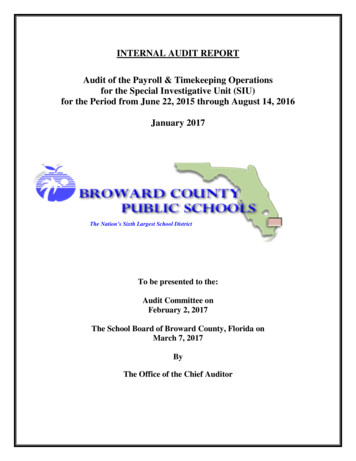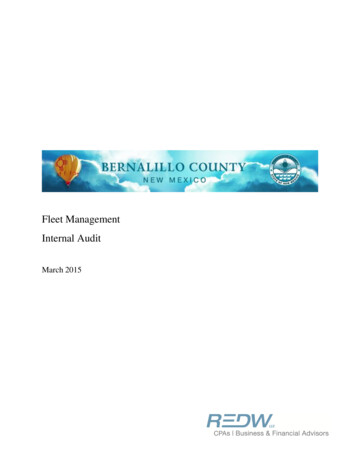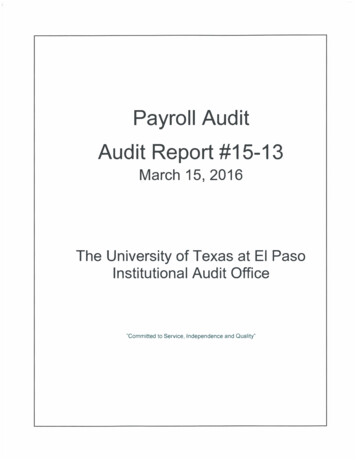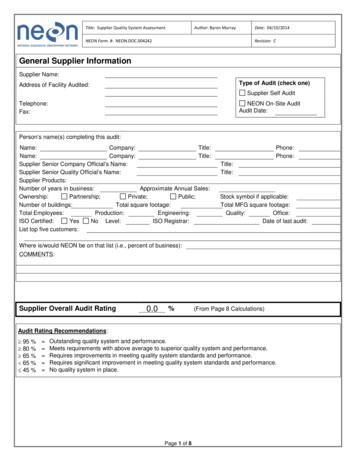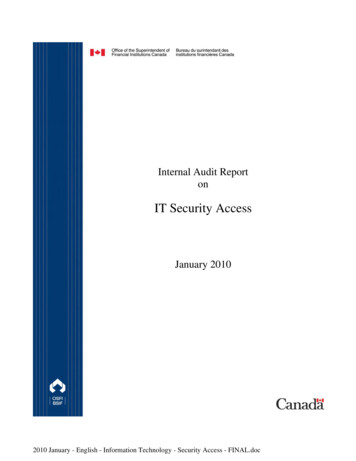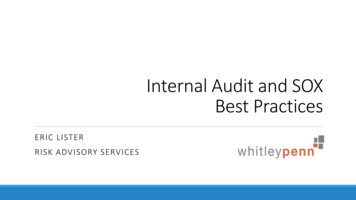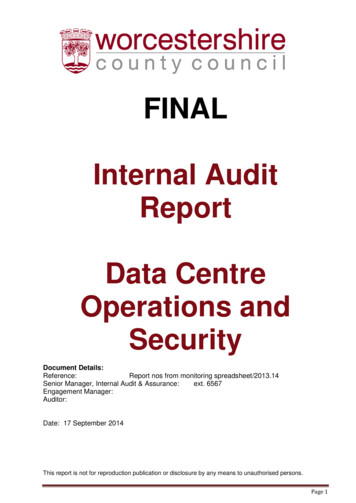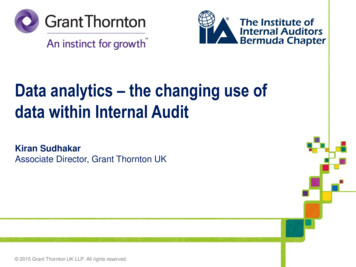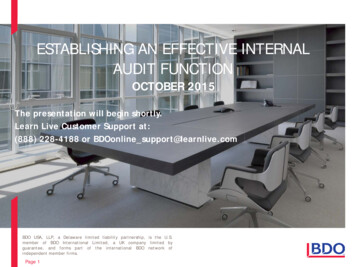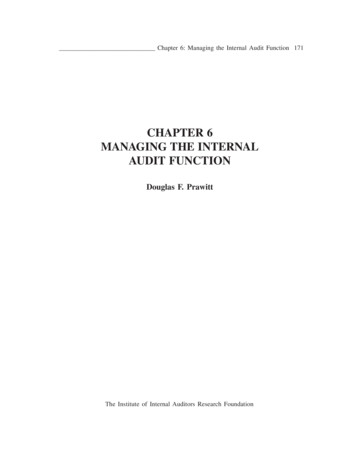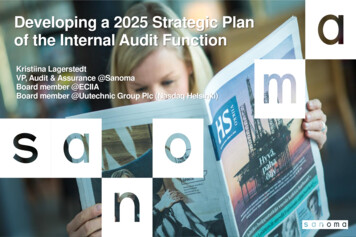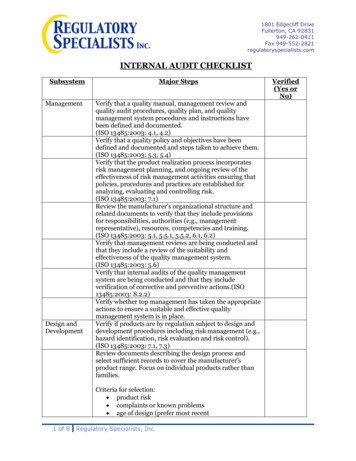
Transcription
Internal Quality Management System Audit Checklist (ISO9001:2015)Q#ISO 9001:2015 ClauseAudit QuestionAudit Evidence4 Context of the Organization4.1 Understanding the organization and its context4.1q1The organization shall determine external andinternal issues that are relevant to its purpose andits strategic direction and that affect its ability toachieve the intended result(s) of its qualitymanagement system.How has the organization determinedexternal and internal issues relevant to itspurpose and strategic direction?How do these affect the ability to achievethe intended result of the QMS?4.1q2The organization shall monitor and review theinformation about these external and internalissues.How do you monitor and review informationabout these internal and external issues?NOTE 1 Understanding the external context can be facilitated by considering issues arising from legal,technological, competitive, market, cultural, social, and economic environments, whether international,national, regional or local.NOTE 2 Understanding the internal context can be facilitated by considering issues related to values, cultureknowledge and performance of the organization.4.2 Understanding the needs and expectations of interested parties4.2q1Due to their impact or potential impact on theorganization’s ability to consistently provideproducts and services that meet customer andapplicable statutory and regulatory requirements,the organization shall determine:a)the interested parties that are relevant to thequality management system;b)the requirements of these interested partiesthat are relevant to the quality managementsystem.How have you determined what interestedparties are relevant to the QMS?How have you determined whatrequirements those parties have that arerelevant to the QMS?How has impact or potential impact beendetermined?4.2q2The organization shall monitor and review theinformation about these interested parties andtheir relevant requirements.How do you monitor and review theinformation about interested parties andtheir relevant requirements?4.3 Determining the scope of the quality management system4.3q1The organization shall determine the boundariesand applicability of the quality managementsystem to establish its scope.How have the boundaries and applicabilityof the QMS been used to establish thescope of the organization?Page !1
Q#ISO 9001:2015 ClauseAudit QuestionAudit Evidence4.3q2When determining this scope, the organizationshall consider:a)the external and internal issues referred to in4.1;b)the requirements of relevant interestedparties referred to in 4.2;c)the products and services of theorganization.How have:The external and internal issues;The requirements of relevant interestedparties and;The products and services of theorganization been considered whendetermining the scope of the organization?4.3q3Where a requirement of this International Standard How has the application of the Internationalwithin the determined scope can be applied, thenStandard within the scope beenit shall be applied by the organization.determined, and how has it been appliedby the organization?4.3q4If any requirement(s) of this International Standardcannot be applied, this shall not affect theorganization’s ability or responsibility to ensureconformity of products and services.How have any requirements of theInternational Standard been determined asnot applicable? Show me how conformity ofproducts and services are not affected bythis.4.3q5The scope shall be available and be maintained asdocumented information stating the:products and services covered by thequality management system;justification for any instance where arequirement of this InternationalStandard cannot be applied.Where is the scope available? Where is itmaintained as documented information?Does it state what products and servicesare covered by the QMS?Does it justify how instances ofrequirements of the QMS cannot beapplied?4.4 Quality management system and its processes4.4q1The organization shall establish, implement,maintain and continually improve a qualitymanagement system, including the processesneeded and their interactions, in accordance withthe requirements of this International Standard.How has the QMS been established? Showme how this is implemented. How is itmaintained and continually improved? Howhave the processes been determined andhow do they interact?Page !2Scope required as documented information.
Q#ISO 9001:2015 ClauseAudit QuestionAudit Evidence4.4q2The organization shall determine the processesneeded for the quality management system andtheir application throughout the organization andshall determine:a) the inputs required and the outputs expectedfrom these processes;b) the sequence and interaction of theseprocesses;c) the criteria, methods, including measurementsand related performance indicators needed toensure the effective operation, and control ofthese processes;d) the resources needed and ensure theiravailability;e) the assignment of the responsibilities andauthorities for these processes;f) the risks and opportunities in accordance withthe requirements of 6.1, and plan and implementthe appropriate actions to address them;g) the methods for monitoring, measuring, asappropriate, and evaluation of processes and, ifneeded, the changes to processes to ensure thatthey achieve intended results;h) opportunities for improvement of the processesand the quality management system.How have the processes been determinedfor the QMS?What are the inputs and outputs for thoseprocesses?What is the sequence and interaction of theprocesses?What are the criteria, methods,measurement and related performanceindicators needed to operate and controlthose processes?What resources are needed and how arethese made available?How are responsibilities and authoritiesassigned for those processes?How are risks and opportunities consideredand what plans are made to implementactions to address them?What methods are used to monitor,measure and evaluate processes and, ifneeded, what changes are made toachieve intended results?How are opportunities to improve theprocesses and the QMS determined?4.4q3The organization shall maintain documentedinformation to the extent necessary to support theoperation of processes and retain documentedinformation to the extent necessary to haveconfidence that the processes are being carriedout as planned.What documented information exists toDocumented information to support the operation ofsupport the operation of processes? How is processes.this documented information retained? Howis confidence that the processes are beingcarried out as planned determined?5 Leadership5.1 Leadership and commitment5.1.1 Leadership and commitment for the quality management systemPage !3
Q#ISO 9001:2015 ClauseAudit QuestionAudit Evidence5.1.1q1Top management shall demonstrate leadershipand commitment with respect to the qualitymanagement system by:a) taking accountability of the effectiveness of thequality management system;b) ensuring that the quality policy and qualityobjectives are established for the qualitymanagement system and are compatible with thestrategic direction and the context of theorganization;c) ensuring that the quality policy iscommunicated, understood and applied within theorganization;d) ensuring the integration of the qualitymanagement system requirements into theorganization’s business processes;e) promoting awareness of the process approach;f) ensuring that the resources needed for thequality management system are available;g) communicating the importance of effectivequality management and of conforming to thequality management system requirements;h) ensuring that the quality management systemachieves its intended results;i) engaging, directing and supporting persons tocontribute to the effectiveness of the qualitymanagement system;j) promoting continual improvement;k) supporting other relevant management roles todemonstrate their leadership as it applies to theirareas of responsibility.Show me how top managementdemonstrates leadership and commitmentw.r.t. the QMS by taking accountability ofthe effectiveness of the QMS.How is the quality policy and objectivesestablished for the QMS and how are theycompatible with the strategic direction andthe organizational context?How is the quality policy communicatedwithin the organization? Show me how thisis understood and applied.How are the requirements of the QMSintegrated into the business processes?How do you promote awareness of theprocess approach?How do you ensure that resources neededfor the QMS area available?How do you communicate the importanceof effective quality management?How do you communicate the importanceof conforming to the QMS requirements?How do you ensure that the QMS achievesits intended results?How do you engage, direct and supportpeople to contribute to the effectiveness ofthe QMS?How do you promote continualimprovement?How do you support other relevantmanagement roles to demonstrateleadership in their areas of responsibility?NOTE Reference to “business” in this International Standard can be interpreted broadly to mean thoseactivities that are core to the purposes of the organization’s existence; whether the organization is public,private, for profit or not for profit.5.1.2 Customer focusPage !4
Q#ISO 9001:2015 ClauseAudit QuestionAudit Evidence5.1.2q1Top management shall demonstrate leadershipand commitment with respect to customer focusby ensuring that:a) customer requirements and applicable statutoryand regulatory requirements are determined andmet;b) the risks and opportunities that can affectconformity of products and services and the abilityto enhance customer satisfaction are determinedand addressed;c) the focus on consistently providing products andservices that meet customer and applicablestatutory and regulatory requirements ismaintained;d) the focus on enhancing customer satisfaction ismaintained.Show me how top managementdemonstrates leadership and commitmentw.r.t. customer focus ensuringrequirements and applicable statutory andregulatory requirements are determinedand met.How are risks and opportunities that canaffect conformity of products and servicesdetermined?How is the ability to enhance customersatisfaction determined and addressed?How is the focus on consistently providingproducts and services that meet customerand applicable statutory and regulatoryrequirements maintained?How is customer satisfaction maintained?5.2 Quality policy5.2.15.2.1q1Top management shall establish, review andmaintain a quality policy that:a) is appropriate to the purpose and context of theorganization;b) provides a framework for setting and reviewingquality objectives;c) includes a commitment to satisfy applicablerequirements;d) includes a commitment to continual improvementof the quality management system.How does top management establish,review and maintain a quality policy?How is it determined to be appropriate tothe purpose and context of theorganization?Does it provide a framework for setting andreviewing quality objectives?Does it contain a commitment to satisfyapplicable requirements?Does it include a commitment to continualimprovement of the QMS?5.2.25.2.2q1The quality policy shall:a) be available as documented information;b) be communicated, understood and appliedwithin the organization;c) be available to relevant interested parties,as appropriate.Where is the quality policy available asdocumented information?How is it communicated?Show me how it is understood and appliedwithin the organization.How have you made it available to relevantinterested parties?5.3 Organizational roles, responsibility and authorities5.3q1Top management shall ensure that theresponsibilities and authorities for relevant rolesare assigned, communicated and understoodwithin the organization.How does top management ensure thatresponsibilities and authorities for relevantroles are assigned, communicated andunderstood within the organization?Page !5Quality Policy as document information
Q#ISO 9001:2015 ClauseAudit QuestionAudit Evidence5.3q2Top management shall assign the responsibilityand authority for:a) ensuring that the quality management systemconforms to the requirements of this InternationalStandard;b) ensuring that the processes are delivering theirintended outputs;c) reporting on the performance of the qualitymanagement system, on opportunities forimprovement and on the need for change orinnovation, and especially for reporting to topmanagement;d) ensuring the promotion of customer focusthroughout the organization;e) ensuring that the integrity of the qualitymanagement system is maintained when changesto the quality management system are plannedand implemented.How does top management assign theresponsibility and authority for:Ensuring that the QMS conforms to theInternational standard?Ensuring processes are delivering theirintended outputs?How is the performance of the QMS,opportunities for improvement and theneed for change or innovation reported totop management?How is customer focus promoted within theorganization?How is the integrity of the QMS maintainedwhen changes to the QMS are planned andimplemented?6 Planning for the quality management system6.1 Actions to address risks and opportunities6.1.16.1.1q1When planning for the quality managementsystem, the organization shall consider the issuesreferred to in 4.1 and the requirements referred toin 4.2 and determine the risks and opportunitiesthatneed to be addressed to:a) give assurance that the quality managementsystem can achieve its intended result(s);b) prevent, or reduce, undesired effects;c) achieve continual improvement.How are the internal and external issuesand interested parties considered whenplanning for the QMS?How are risks and opportunities determinedand addressed so that the QMS can::a)achieve its intended results;b)Prevent or reduce undesired effects;c)Achieve continual improvement?6.1.26.1.2q1The organization shall plan:a) actions to ad
Internal Quality Management System Audit Checklist (ISO9001:2015) Q# ISO 9001:2015 Clause Audit Question Audit Evidence 4 Context of the Organization 4.1 Understanding the organization and its context 4.1q1 The organization shall determine external and internal issues that are relevant to its purpose and its strategic direction and that affect its ability to achieve the intended result(s) of .
